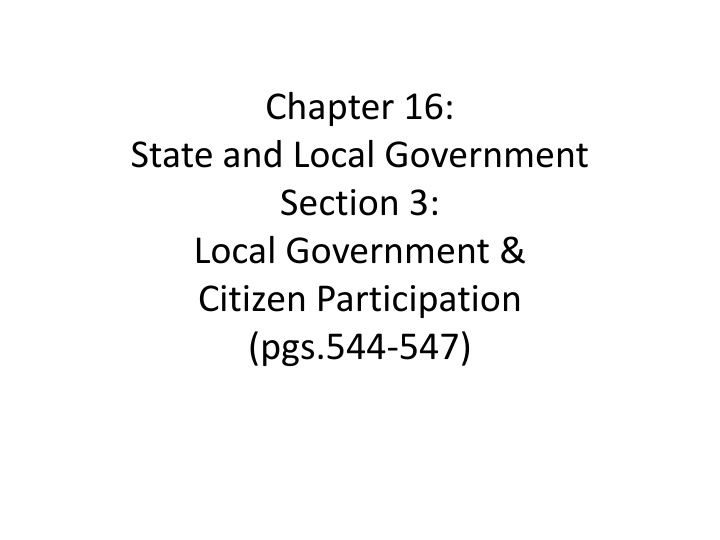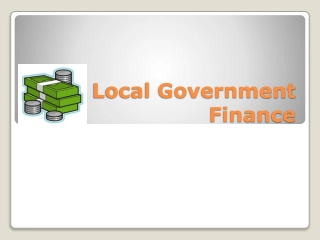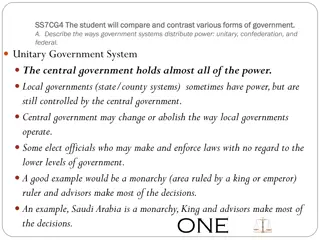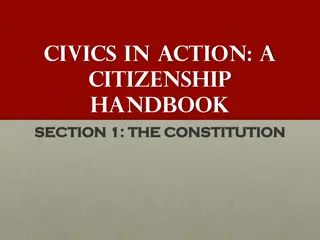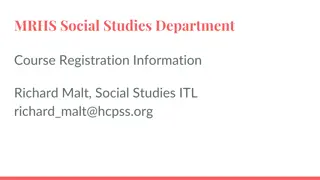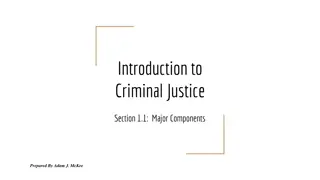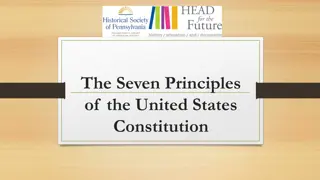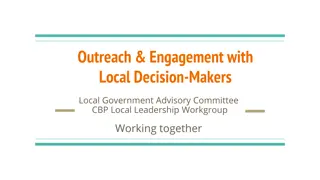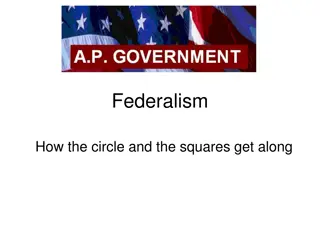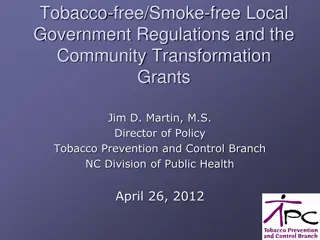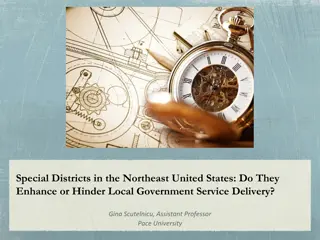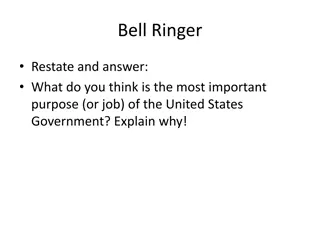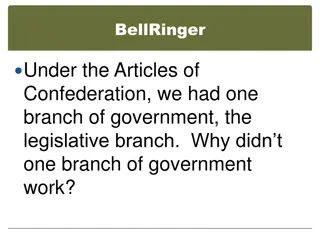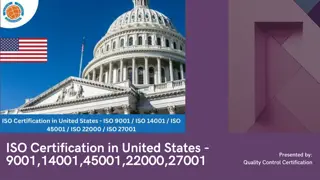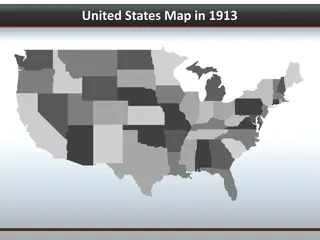Overview of Local Government in the United States
Local government in the U.S. consists of counties, cities, towns, and special districts, providing essential services like police and fire departments, libraries, and waste treatment facilities. With about 88,000 local governments, citizens live under their jurisdiction, electing officials and participating in decision-making processes to shape their communities.
Download Presentation

Please find below an Image/Link to download the presentation.
The content on the website is provided AS IS for your information and personal use only. It may not be sold, licensed, or shared on other websites without obtaining consent from the author.If you encounter any issues during the download, it is possible that the publisher has removed the file from their server.
You are allowed to download the files provided on this website for personal or commercial use, subject to the condition that they are used lawfully. All files are the property of their respective owners.
The content on the website is provided AS IS for your information and personal use only. It may not be sold, licensed, or shared on other websites without obtaining consent from the author.
E N D
Presentation Transcript
Chapter 16: State and Local Government Section 3: Local Government & Citizen Participation (pgs.544-547)
Local Government http://bremondtexas.org/images/polski_dzien1.png While there is only one national government and 50 state governments, there are about 88,000 local governments in the U.S. Every American lives under the jurisdiction of one or more local governments.
Local Governments--Counties All states are divided into counties (except parts of New England), these are the most basic unit of local government. In Louisiana counties are called parishes and in Alaska they are called boroughs. Most of the nation s 3,000 counties are governed by an elected county board. This board usually has five members and they are elected for four-year terms. They meet regularly to exercise executive and legislative power over the county. In some states, in the Midwest, counties are divided into townships. There are 16, 500 townships that assist the county to deliver services to rural areas. https://upload.wikimedia.org/wikipedia/commons/thumb/2/2e/Map_of_Texas_highlighting_Robertson_County.svg/200px-Map_of_Texas_highlighting_Robertson_County.svg.png Robertson County
Local GovernmentsCities & Towns In addition to the country s counties and townships, people have formed Municipalities the nation s cities, towns and villages. There are 20,000 municipalities in the U.S. To become a city or town the state gives its legal authority through incorporation. There are three main forms of municipal government. 1st the mayor-council system, citizens elect a mayor to serve as the chief executive and the city council to serve as the local legislature. 2nd the council-manager system, the city council appoints a city manager to be chief executive. In this system, the mayor s role is to lead the city council. 3rd the commission system, a group of elected commissioners lead city departments and set local policies. http://cstx.gov/modules/ShowImage.aspx?imageid=5107
Local GovernmentsSpecial Districts http://www.rcssc.org/images/bremond.jpg The greatest number of local governments are special districts. These districts provide a single service, such as water or transportation, to a defined area. The most well known is the school district. Of the 48,878 in the U.S. 13, 522 are school districts.
Services of Local Government Counties typically provide the most essential services. These services include police and fire departments, public roads, welfare programs, hospitals, jails, keeping records like marriage licenses, and supervising elections. Municipal governments provide services like libraries, recreation facilities, garbage collection and waste treatment facilities. Cities also pass zoning laws to regulate land use. http://1.bp.blogspot.com/_5Evelepcipg/S3BkhG6mLVI/AAAAAAAAA_Y/863f-GWbuP8/s320/Library%5B1%5D.jpg
Finances of Local Government To raise money, local governments asses taxes, collect fees, and receive state and federal grants (intergovernmental revenues). Local governments collect property taxes on land, homes, cars and business property, this is the biggest source of revenue. Schools and churches do not pay taxes. Most local governments collect sales tax and income taxes. Local governments can also raise money by selling municipal bonds. http://roselawgroupreportercom.c.presscdn.com/wp-content/uploads/2014/05/property-tax-rise-h1.jpg
Participatory Citizenship Democracy works best when citizens monitor public policy and take action to make their interests known. Citizens who are 18 and older get to vote in elections and run for public office. Citizens of all ages may volunteer in their communities or testify before state or local boards. http://www.hcpl.net/sites/default/files/Voting%20blog.jpg http://i2.cdn.turner.com/cnnnext/dam/assets/120703074240-norden-voting-rights-story-top.jpg
Direct Democracy http://blog.tavorro.com/wp-content/uploads/2014/11/Taking-Initiative-Tavorro-Careers-e1416246585234-660x330.png Some forms of participatory citizenship even have the force of law. Initiative-allows citizens to propose and enact state and local laws directly by starting a petition to support a bill, then the bill either goes to the state legislature, or the people vote on the bill directly. 24 states have the initiative.
Direct Democracy http://previews.123rf.com/images/tribalium123/tribalium1231304/tribalium123130400096/19317088-voting-in-the-referendum-illustration-of-a-ballot-box-hand-putting-a-voting-ballot-in-a-slot-of-box--Stock-Vector.jpg A referendum is a popular vote on a proposal that has already been considered by the legislature. Many state constitutional amendments must be approved by referendum. Every state has this except Alabama. The recall process allows citizens to remove government officials from office before the end of a term.
